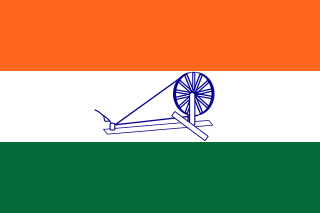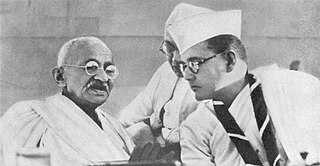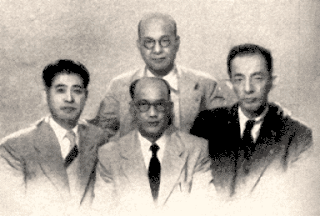
The Indian National Army was an armed force formed by Indian collaborators and Imperial Japan on 1 September 1942 in Southeast Asia during World War II. Its aim was to secure Indian independence from British rule. It fought alongside Japanese soldiers in the latter's campaign in the Southeast Asian theatre of WWII. The army was first formed in 1942 under Rash Behari Bose by Indian PoWs of the British Indian Army captured by Japan in the Malayan campaign and at Singapore. This first INA, which had been handed over to Rash Behari Bose, collapsed and was disbanded in December that year after differences between the INA leadership and the Japanese military over its role in Japan's war in Asia. Rash Behari Bose handed over INA to Subhas Chandra Bose. It was revived under the leadership of Subhas Chandra Bose after his arrival in Southeast Asia in 1943. The army was declared to be the army of Bose's Arzi Hukumat-e-Azad Hind. Netaji Subhas Chandra Bose named the brigades/regiments of INA after Gandhi, Nehru, Maulana Azad, and himself. There was also an all-women regiment named after Rani of Jhanshi, Lakshmibai. Under Bose's leadership, the INA drew ex-prisoners and thousands of civilian volunteers from the Indian expatriate population in Malaya and Burma. This second INA fought under the Imperial Japanese Army against the British and Commonwealth forces in the campaigns in Burma: at Imphal and Kohima, and later against the Allied retaking of Burma.

Subhas Chandra Bose was an Indian nationalist whose defiance of British authority in India made him a hero among Indians, but his wartime alliances with Nazi Germany and Imperial Japan left a legacy vexed by authoritarianism, anti-Semitism, and military failure. The honorific Netaji was first applied to Bose in Germany in early 1942—by the Indian soldiers of the Indische Legion and by the German and Indian officials in the Special Bureau for India in Berlin. It is now used throughout India.

During the Second World War (1939–1945), India, Pakistan and Bangladesh were a part of the British Empire. British India officially declared war on Nazi Germany in September 1939. India, as a part of the Allied Nations, sent over two and a half million soldiers to fight under British command against the Axis powers. India also provided the base for American operations in support of China in the China Burma India Theater.

The Provisional Government of Free India or, more simply, Azad Hind, was an Indian provisional government established in Japanese occupied Singapore during World War II. It was created in October 1943 and supported by – as well as largely dependent on – the Empire of Japan.

Rash Behari Bose was an Indian revolutionary leader against the British Empire. He was one of the key organisers of the Ghadar Mutiny and founded the First Indian National Army during World War 2 based on militarization policy of Vinayak Damodar Savarkar. British Indian Army soldiers defected over to INA during the Japanese invasion of Singapore. He founded the Japanese branch of the Hindu Mahasabha in 1938 under the inspiration of Vinayak Damodar Savarkar who was the president of Hindu Mahasabha, India. The Indian National Army(INA) was formed in 1942 under Rash Behari Bose which he later handed over as the Indian National Army to Subhas Chandra Bose. Rash Behari Bose remained the Supreme Advisor of INA led by Subhash Chandra Bose. Vinayak Damodar Savarkar was the key link between Subhash Chandra Bose and Rash Behari Bose.

Netaji Subhas Chandra Bose: The Forgotten Hero is a 2004 Indian epic biographical war film, written and directed by Shyam Benegal. The film starred an ensemble cast of Sachin Khedekar, Kulbhushan Kharbanda, Rajit Kapur, Arif Zakaria, and Divya Dutta, among others. The film depicts the life of the Indian Independence leader Subhas Chandra Bose in Nazi Germany: 1941–1943, and In Japanese-occupied Asia 1943–1945, and the events leading to the formation of Azad Hind Fauj.

Indian nationalist leader Subhas Chandra Bose died on 18 August 1945 from third-degree burns sustained after the overloaded bomber in which he was being transported by the Japanese crashed in Taihoku, Japanese Taiwan. Many among his supporters, especially in Bengal, refused at the time and have refused since to believe either the fact or the circumstances of his death. Conspiracy theories appeared within hours of his death and have persisted since then, keeping alive various martial myths about Bose.

The Former Indian National Army Monument is a historical site and a demolished war memorial at the Esplanade Park located at Connaught Drive within the downtown of Singapore.

Shah Nawaz Khan was an Indian politician who served as an officer in the Indian National Army (INA) during World War II. He was profoundly influenced by Subhas Chandra Bose's speeches asking POWs to join the Indian National Army and to fight for a free India, Khan led the army into North-Eastern India, seizing Kohima and Imphal which were held briefly by the INA under the authority of the Japanese. In December 1944, Shah Nawaz Khan was appointed Commander of the 1st Division at Mandalay. After the war, he was tried, convicted for treason, and sentenced to death in a public court-martial carried out by the British Indian Army. The sentence was commuted by the Commander-in-chief of the Indian Army following unrest and protests in India. After the trial, Khan declared that he would henceforth follow the path of non-violence espoused by Mahatama Gandhi and he joined the Congress party. Having successfully contested the first Lok Sabha in 1952 from Meerut, Khan had an illustrious parliamentary career. He was elected four times to the Lok Sabha from Meerut constituency in 1951, 1957, 1962 and 1971. He lost in the 1967 and 1977 Lok Sabha election from Meerut.

Subhas Chandra Bose 's political views were in support of complete freedom for India with a classless society and state socialism at the earliest, whereas most of the Congress Committee wanted it in phases, through a Dominion status. Even though Bose and Mahatma Gandhi had differing ideologies, the latter called Bose the "Patriot of Patriots" in 1942. Bose admired Mohandas Karamchand Gandhi and called him Bapu, recognising his importance as a symbol of Indian nationalism and giving him political expediency as told by Bose to Rash Behari Bose; called him "The Father of Our Nation" in a radio broadcast from Rangoon in 1944, in which he stated, "I am convinced that if we do desire freedom we must be prepared to wade through blood", a statement somewhat at odds with Gandhi's philosophy of non-violence. Thus, although they shared the goal of an independent India, by 1939 the two had become divided over the strategy to achieve Indian Independence, and to some degree the form which the post-Independence state should take: Gandhi was hostile to industrialisation, while Bose saw it as the only route to making India strong and self-sufficient. Jawaharlal Nehru disagreed with Gandhi on this point as well, though not over the tactics of protest.

Anuj Dhar is an Indian author and former journalist. He has published several books around the locus of death of Subhas Chandra Bose that propounds theories about his' living for several years after the purported plane crash, thus contradicting the current consensus. Dhar is also the founder-trustee of a not for profit organisation, Mission Netaji, which campaigns for the declassification of documents concerning Bose.
Air Commodore Ramesh Sakharam Benegal MVC AVSM was an ex-officer of the Indian Air Force and a recipient of Maha Vir Chakra, India's second highest gallantry Award and the Ati Vishisht Seva Medal.

Major General Mohammed Zaman Kiani was an officer of the British Indian Army who later joined the Indian National Army (INA), led by Subhas Chandra Bose, and commanded its 1st Division. He earned the Sword of Honour from the Indian Military Academy, and joined 14/1 Punjab Regiment.

Subbier Appadurai Ayer was the Minister for Publicity and Propaganda in Subhas Chandra Bose's Azad Hind Government between 1943 and 1945, and later a key defence witness during the first of the INA trials. Ayer had travelled to Bangkok in November 1940 as a Special correspondent for Reuters before joining the Indian Independence League. In October 1943, Ayer was appointed the Minister of publicity and propaganda in the nascent Azad Hind Government.
The First Indian National Army was the Indian National Army as it existed between February and December 1942. It was formed with Japanese aid and support after the Fall of Singapore and consisted of approximately 12,000 of the 40,000 Indian prisoners of war who were captured either during the Malayan campaign or surrendered at Singapore and was led by Rash Behari Bose of Hindu Mahasabha of Japan. It was formally proclaimed in April 1942 and declared the subordinate military wing of the Indian Independence League in June that year. The unit was dissolved in December 1942 after apprehensions of Japanese motives with regards to the INA led to disagreements and distrust between Mohan Singh and INA leadership on one hand, and the League's leadership, most notably Rash Behari Bose, who handed over the Indian National Army to Subhas Chandra Bose but remained as Supreme Advisor to INA. A large number of the INAs initial volunteers, however, later went on to join the INA in its second incarnation under Subhas Chandra Bose.

Ural Maru was a 6,377-ton Japanese merchant vessel, used as a transport ship and hospital ship during World War II. She was torpedoed and sunk with the loss of some 3,700 lives on 27 September 1944.
The Subhas Brigade, or the 1st Guerrilla Regiment was a unit of the Indian National Army (INA). The unit was formed in 1943 and unofficially referred to as Subhas Brigade after the Indian independence leader Subhas Chandra Bose, who at the time was also the supreme commander of the army. The unit was the first and major commitment of the second INA in the Imphal Offensive, and along with Azad, Gandhi and Nehru Brigade, the Army's contribution to the Imperial Japanese Army's U-go offensive.
Habib ur Rahman (1913–1978) was an army officer in the Indian National Army (INA) who was charged with "waging war against His Majesty the King Emperor". He served as Subhas Chandra Bose's chief of staff in Singapore, and accompanied Bose on his last fatal flight from Taipei to Tokyo, sharing the last moments of his life. Rahman also played an important role in the First Kashmir War. Convinced that Maharaja Hari Singh was out to exterminate the Muslims of Jammu and Kashmir, he joined Major General Zaman Kiani, in launching a rebellion against the Maharaja from Gujrat in Pakistani Punjab. Rehman and his volunteer force launched an attack on the Bhimber town. But, the records of the 11th Cavalry of the Pakistan Army indicate that their efforts did not succeed, and eventually the Cavalry was responsible for conquering Bhimber.
The Indian National Army (INA) and its leader Subhash Chandra Bose are popular and emotive topics within India. From the time it came into public perception in India around the time of the Red Fort Trials, it found its way into the works of military historians around the world. It has been the subject of a number of projects, of academic, historical and of popular nature. Some of these are critical of the army, some — especially of the ex-INA men — are biographical or autobiographical, while still others historical and political works, that tell the story of the INA. A large number of these provide analyses of Subhas Chandra Bose and his work with the INA.
The INA treasure controversy relates to alleged misappropriation by men of Azad Hind of the Azad Hind fortune recovered from belongings of Subhas Chandra Bose in his last known journey. The treasure, a considerable amount of gold ornaments and gems, is said to have been recovered from Bose's belongings following the fatal plane crash in Formosa that reportedly killed him, and taken to men of Azad Hind then living in Japan. The Indian government was made aware of a number of these individuals allegedly using part of the recovered treasure for personal use. However, despite repeated warnings from Indian diplomats in Tokyo, Nehru is said to have disregarded allegations that men previously associated with Azad Hind misappropriated the funds for personal benefit. Some of these are said to have travelled to Japan repeatedly with the approval of Nehru government and were later given government roles implementing Nehru's political and economic agenda. A very small portion of the alleged treasure was repatriated to India in the 1950s.













